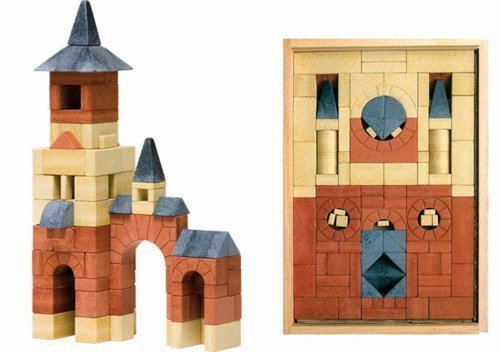 | ||
Richter s votiefkerk van ankersteen votivkirche von ankerstein votive church from anchor stone blocks
Anchor Stone Blocks (German: Anker-Steinbaukasten) are components of stone construction sets made in Rudolstadt, Germany used as a construction toy.
Contents
- Richter s votiefkerk van ankersteen votivkirche von ankerstein votive church from anchor stone blocks
- Description
- Origin
- End and rebirth
- Anchor today
- Cultural influences
- References
Description
Anchor Stone pieces originally were and are still made of a mixture of quartz sand, chalk, and linseed oil (German Patent 13,770; USA Patent 233,780), precisely pressed in molds so that they fit together perfectly. The stones come in three colors in imitation of the red brick, tan limestone, and blue slate of European buildings. They are not recommended for play by children under 3 years of age because of their small size. (CE No. 0494)
Origin
Anchor stones originated with the wooden building blocks which were designed by Friedrich Fröbel, the creator of the Kindergarten system. He observed how children enjoyed playing with geometrically shaped blocks.
The first Anchor Stone was produced when Otto Lilienthal and his brother Gustav decided that make a model of a stone building, using miniature blocks of stone. To this end, they started production of a limited number of blocks, made of a mixture of quartz sand, chalk, and linseed oil. Unfortunately, the Lilienthals, though brilliant inventors, had limited commercial success.
The stone blocks saw little popularity until 1880, when F. Ad. Richter, a wealthy businessman who had built a small empire in Rudolstadt, purchased the rights to the stone for 1000 marks (about €510), plus about 4800 marks (including 800 marks still owing) for the tooling and machines being used to produce them. He quickly developed a series of sets of individually packaged stones. The stone blocks sets quickly became popular. Thanks to advertising, during 1883 42,000 sets were sold. (Annual Report for 1883 of the Schwarzburg-Rudolstadt Factory Inspection Service, Archives, Heidecksburg, Rudolstadt) In 1894, Richter applied his "Anchor" trademark to the Richter's Anchor Stone Building Sets (Richters Anker-Steinbaukasten). The more than 600 different sets were produced over the multi-decade life of these sets; more than 1,000 stone shapes were made (CVA Stone Catalog). In 1910 Richter died, heralding the end of the first era for Anchor Stones. (Registered as death # 878 in Jena on December 27, 1910; he died at 9:00 PM on December 25, 1910.)
End and rebirth
Although Anchor Stones survived World War I and World War II, the factory was included within Communist East Germany when the Iron Curtain divided Europe. In 1953, the company was nationalized as VEB Anker-Steinbaukasten, a state-owned company. In 1963, the production of the blocks was stopped. The trademark "Anker" was used by various toy companies in East Germany, none of which were related to the stone building set factory.
However, existing sets of old Anchor Stones remained very popular within the international community; in 1979, the Club van Ankervrienden (Club of Anchor Friends) was founded in the Netherlands. Initially the membership was limited to the Dutch; in 1983 foreign members were admitted. Today the club has about 230 members. The Berlin Wall fell in 1989, hastening the decline of communism. With the support of the Club of Anchor Friends, Dr. Georg Plenge was able to restore the company as Anker Steinbaukasten GmbH. Production at the factory in Rudolstadt restarted 15 September 1994 (New sets sold to Club members in October, 1994.)
Anchor today
The new factory manufactures and sells all 15 of the sets in the main series (GK-NF) of Anchor sets as well as some sets remodelling the Michaelis Basilika in Hildesheim and the Brandenburg Gate. They are widely available in Germany, including in the KaDeWe department store in Berlin, and are readily available online. A new series of sets for younger children called Die neue Steinzeit was introduced in 2012. The sets tend to be expensive, but high-quality; antique sets are just as playable now as when they were being produced. Sets being produced today are made to the same specifications as the antique ones, so they can be easily integrated. In addition to construction sets, the artificial stone formula has been used to produce simple flat puzzles, such as tangrams.
Cultural influences
Famous people like Max Born, J. Robert Oppenheimer, Albert Einstein, and Walter Gropius developed their creativity by playing with Anchor stones. Anchor Stones have been displayed in the Louvre and Deutsches Museum. They appear in a fairly prominent role in Jan Švankmajer's Neco z Alenky as, among other things, the home of the White Rabbit. They also support a plot sequence in The Diamond in the Window, by Jane Langton.
